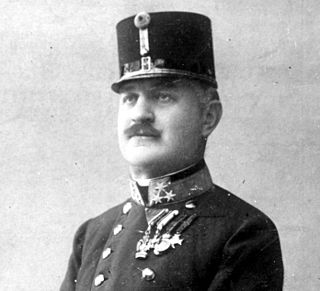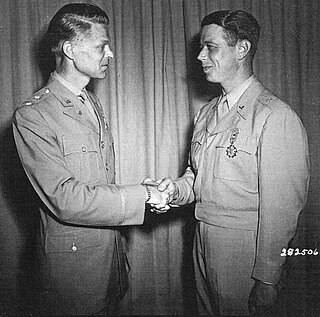Related Research Articles

Signals intelligence (SIGINT) is the act and field of intelligence-gathering by interception of signals, whether communications between people or from electronic signals not directly used in communication. As classified and sensitive information is usually encrypted, signals intelligence may necessarily involve cryptanalysis. Traffic analysis—the study of who is signaling to whom and in what quantity—is also used to integrate information, and it may complement cryptanalysis.
MI8, or Military Intelligence, Section 8 was a British Military Intelligence group responsible for signals intelligence and was created in 1914. It originally consisted of four sections: MI8(a), which dealt with wireless policy; MI8(b), based at the General Post Office, dealt with commercial and trade cables; MI8(c) dealt with the distribution of intelligence derived from censorship; and MI8(d), which liaised with the cable companies. During World War I MI8 officers were posted to the cable terminals at Poldhu Point and Mullion in Cornwall and Clifden in County Galway, continued until 1917 when the work was taken over by the Admiralty. In WW2, MI8 was responsible for the extensive War Office Y Group and briefly, for the Radio Security Service.

Alfred Redl was an Austro-Hungarian military officer who rose to head the Evidenzbureau, the counterintelligence wing of the General Staff of the Austro-Hungarian Army. He was one of the leading figures of pre-World War I espionage; his term in office was marked by radical innovations and the use of advanced technology to ensnare foreign spies.
Cravath, Swaine & Moore LLP is an American white-shoe law firm headquartered in New York City. The firm has additional offices in London and Washington, D.C.

Ralph Henry Van Deman was a United States Army officer, sometimes described as "the father of American military intelligence." He is in the Military Intelligence Hall of Fame.

The Ministry of Public Security, was the secret police, intelligence and counter-espionage agency operating in the Polish People's Republic. From 1945 to 1954 it was known as the Security Office, and from 1956 to 1990 as the Security Service.
Howard Charles Petersen was an American government official and banker. He was the United States Assistant Secretary of War from 1945 to 1947.
With the rise of easily-intercepted wireless telegraphy, codes and ciphers were used extensively in World War I. The decoding by British Naval intelligence of the Zimmermann telegram helped bring the United States into the war.
The 1943 BRUSA Agreement was an agreement between the British and US governments to facilitate co-operation between the US War Department and the British Government Code and Cypher School (GC&CS). It followed the 1942 Holden Agreement.

Paul Drennan Cravath was a prominent American corporate lawyer and presiding partner of the New York law firm known today as Cravath, Swaine & Moore. At the firm, he devised and implemented the Cravath System, which has come to define the structure and practice of most large American firms.
The Pond was a small, secret organization formed by the government of the United States which operated between 1942 and 1955. It engaged in espionage. It was formally acknowledged by the US government in 2001.

Roswell Foster Magill was an American tax lawyer and Treasury Department official. He was one of the most important tax officials of the 1930s and one of the leading tax experts.
The Cravath System is a set of business management principles first developed at Cravath, Swaine & Moore. John Oller, author of White Shoe, credits Paul Drennan Cravath with creating the model in the early 20th century, which was adopted by virtually all white-shoe law firms, fifty years before the phrase white shoe came into popular use. The Cravath System has been adopted by many leading law firms, strategy consulting agencies, and investment banks in the United States.
William Wemple was an American lawyer.

James McCormack Jr. was a United States Army officer who served in World War II, and was later the first Director of Military Applications of the United States Atomic Energy Commission.

C. Allen Parker is an American business executive and attorney. He was the senior executive vice president and general counsel of Wells Fargo, and also served as its interim CEO and president. Prior to joining Wells Fargo, Parker was a partner at New York law firm Cravath, Swaine & Moore LLP, and served as its fifteenth presiding partner.
Frederick August Otto "Fritz" Schwarz Jr. is an American lawyer born in New York City.

The Military Intelligence Division was the military intelligence branch of the United States Army and United States Department of War from May 1917 to March 1942. It was preceded by the Military Information Division and the General Staff Second Division and in 1942 was reorganised as the Military Intelligence Service.
The 1890 Birthday Honours were appointments by Queen Victoria to various orders and honours to reward and highlight good works by citizens of the British Empire. The appointments were made to celebrate the official birthday of The Queen, and were published in the London Gazette on 20 May 1890 and in The Times on 21 May 1890.
References
- 1 2 3 4 5 6 7 8 9 10 11 "Alfred McCormack, Lawyer, Dies". New York Times. 12 July 1956. p. 23. Retrieved 26 December 2022.
- 1 2 3 4 5 6 7 Nicholas Reynolds (19 August 2021). "How a Wall Street Lawyer Saved G.I.'s Lives". Wall Street Journal. Retrieved 26 December 2022.
- ↑ Budiansky, Stephen (2016). Code Warriors. New York: Alfred A. Knopf. pp. 27–28, 114, 172. ISBN 9780385352666.
- ↑ Interlocking Subversion in Government Departments - Part 13. USGPO. 25 June 1953. pp. 872–873. Retrieved 22 December 2022.
- ↑ "Army Distinguished Service Medal". Hall of Valor Project. Retrieved 26 December 2022.
- ↑ "Colleagues Celebrate the Career of Robert Scott, Alfred McCormack Professor of Law, Emeritus". Columbia Law School. 19 August 2021. Retrieved 26 December 2022.
- ↑ "Col. Alfred McCormack Preserve". Redding Land Trust. Retrieved 26 April 2024.